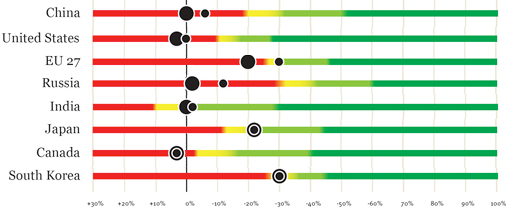 The poster child of human environmental destruction in the 90’s is still imperiled, even if the focus has shifted to global warming. Of course the two are intimately related, and besides the forests’ huge impacts on local watersheds—effectively creating their own rain—the forests’ trees and soils obviously have a major impact on the carbon cycle. Still, the onslaught upon the lungs of the world is not only unrelenting but expanding. Continue reading
The poster child of human environmental destruction in the 90’s is still imperiled, even if the focus has shifted to global warming. Of course the two are intimately related, and besides the forests’ huge impacts on local watersheds—effectively creating their own rain—the forests’ trees and soils obviously have a major impact on the carbon cycle. Still, the onslaught upon the lungs of the world is not only unrelenting but expanding. Continue reading
Author Archives: JPierce
Extreme documentaries
Last week’s episode of NOVA Extreme Cave Diving was an interesting foray into “blue holes,” and the evidence they offer of paleo-climate. If you missed it, check the website to view it online. Similar, though less-breath taking evidence is offered in a recent paper from Yale.
This week’s Extreme Ice, provides a stunning and more in-depth review of the photographic documentation of glacial melting by James Balog, which we have mentioned before.
Beyond Petroleum?
Given the monopolistic and powerful positions adopted by the oil companies since the beginning of the modern oil age in the nineteenth century, it is almost inevitable that their entry into the renewable arena will not be without problems. — ScienceBlog.com
Even with ‘Copenhagen,’ toasty times ahead
Last week I wrote about the post-COP15 emissions target deadline that whizzed by for most of the planet, and tried to put it into context. Of course, the larger question of what the resulting cuts would mean with regards to future warming remained unanswered, due to it being written during the wee hours of the morning. Fortunately, someone else also crunched the numbers and compared them to model predictions, New Scientist reports, arriving at a most unfortunate (but unsurprising) answer.
Electronics Recycling II
 Sarah previously wrote about safe and ethical electronics recycling, and we follow up today with a little information about additional options.
Sarah previously wrote about safe and ethical electronics recycling, and we follow up today with a little information about additional options.
Office supply stores like Staples often have recycling programs1 for computers and peripherals, including cash back for ink and toner cartridges if you prefer not to bring them to a local refill business like InkTec Zone or Cartridge World franchise.
Staples is also offering $50 trade-in rebates on old printers through April 3. If you do opt for a new printer, be sure to look at reviews and specifications regarding durability, ink frugality, and power consumption.
1. The equipment is picked up and delivered to our recycling partner, Eco International, who disassembles the equipment into its component parts for environmentally responsible recycling in the U.S. (Staples Recycling FAQ)
Initial information provided by “k / total recycling”
Site Notes
Your humble editors would like to expand the number and variety of voices on Warm Home Cool Planet by extending an offer to our readership seeking additional local contributors. Although we can only offer a modicum of glory, it can be interesting and rewarding to share news and views with others. If you’re interested but not sure what to write about, please do not let this dissuade you, we maintain a fresh spool of topic prompts. Do you already publish an environmentally themed blog? We would be happy to syndicate or ‘cross-post’ select articles. For more information about contributing please contact us.
P.S. In addition to the new streaming calendar in the header above, we also recently added a voting system to the site. If you could, please take a moment to vote on posts after reading them. This feedback can help encourage authors, and also inform us of the sort of topics you are interested in reading about.
55 countries down…?
 There’s a lot of press today about the fact that 55 countries have submitted emissions reduction pledges to the U.N. as the deadline drew passed; note that 27 of them are in the EU. New Scientist has a nice summary, and Reuters India lists most of the targets.
There’s a lot of press today about the fact that 55 countries have submitted emissions reduction pledges to the U.N. as the deadline drew passed; note that 27 of them are in the EU. New Scientist has a nice summary, and Reuters India lists most of the targets.
Some of the more disappointing targets include our own, our neighbors to the north, and Korea. “The US previously pledged a cut of 17% from 2005 levels by 2020 (equivalent to 3% from the conventional baseline of 1990)” (BBC). True to its word, the increasingly conservative Canadian government submitted the same relative target as the U.S. South Korea—whose emissions have more than doubled since 1990—has committed to an even smaller cut of 4% of 2005 levels. However, it has tries to play up the significance of these cuts by calling them a 30% cut from business as usual.
Below you can find a summary of the pledges of the top eight emitters (78%) of carbon dioxide, and what their effect might be. Please note that barring an international agreement in Mexico next winter, China and India’s targets are even less firm than those of other nations since they have vowed to decrease intensity (increase efficiency) by 40-45% & 16-20% respectively, rather than make cuts towards a specific target. These estimates are therefore a best case scenario under the unlikely condition of zero future growth.
| Baseline | 2007 | % Global | Cut | 2020 | |||
|---|---|---|---|---|---|---|---|
| MT CO2 | Year | MT CO2 | MT CO2 | ||||
| 1 | China | 6083.0 | 2007 | 6083.0 | 27.57% | 40.00% | 3649.8 |
| 2 | U.S. | 5857.1 | 2005 | 5853.5 | 26.53% | 17.00% | 4861.4 |
| E.U. | 4135.4 | 1990 | 3971.1 | 18.00% | 20.00% | 3308.3 | |
| 3 | Russia | 2302.6 | 1990 | 1579.0 | 7.16% | 20.00% | 1842.1 |
| 4 | India | 1369.9 | 2007 | 1369.9 | 6.21% | 16.00% | 1150.7 |
| 5 | Japan | 1069.4 | 1990 | 1235.1 | 5.60% | 25.00% | 802.1 |
| 8 | Canada | 543.4 | 2005 | 540.8 | 2.45% | 17.00% | 451.0 |
| 9 | South Korea | 361.4 | 2005 | 499.0 | 2.26% | 4.00% | 346.9 |
| World | 2007 | 29320.0 | 16.09% | 24600.9 | |||
MT = megatonne. approximately 2.2 billion pounds.
Countries 7 & 8 are the United Kingdom and Germany, both members of the European Union.
Sources: Emissions data, and pledges from stories linked in this post.
Ecosystem foot cubed
 National Geographic has an interesting article about “the amount of life you can find in one cubic foot” of various ecosystems around the world. The article itself is short on details about the method, but beautifully written. For a description of the process watch the attached videos. Hint: It’s not an instantaneous cubic foot.
National Geographic has an interesting article about “the amount of life you can find in one cubic foot” of various ecosystems around the world. The article itself is short on details about the method, but beautifully written. For a description of the process watch the attached videos. Hint: It’s not an instantaneous cubic foot.
Environmental pawprints
Lest our dog-owning readers think that the above comic unfairly singles out their pooches, note that the original research it is commenting upon is not limited to canines. It turns out that a variety of pets have numerous, oft-overlooked consequences for the environment, be it illegal bird and fish trafficking, or the insistence that Fluffy should eat better than her owner. The latter is a rather disturbing and unnatural trend since undomesticated Felis and Canis eat as much of their prey as they can, offal and all. Indeed, one of the major impacts of free ranging cats is songbird predation.
Water pollution is another unfortunate side-effect of pets. Pooper-scooper laws are not just about aesthetics and clean shoes, but public and environmental health. Besides carrying a variety of pathogens, Spot’s spots are essentially fertilizer and can contribute to algal blooms and fish kills if they make it into water ways. It is especially important to clean up after your dog—and there are free baggie dispensers in case you forget to grab some on your way out—if you bring him to Fresh Pond, since this beautiful water body is an important wildlife habitat and a part of our water supply. Cat waste can also contribute to water pollution. Flushable litter has lead to the decline of Californian sea otters, and it can infect other wildlife as well e.g; filter-feeders such as oysters and clams. Other choices of litter are also problematic, although a variety of less harmful options are available.
None of this is to say that you should not have a pet, or dissuade you from pets in the future, but merely to add to the list of things you should consider before doing so besides whether or not you have the necessary time to devote to the pet’s care and convincing your landlord/partner to allow it.
- Adopt rather than buy, and if you’re leaning towards exotics be sure to purchase from a reputable dealer.
- Always spay or neuter.
- Keep Fluffy indoors, and clean up after Spot.
- Although Fluffy (arguably) cannot survive on bread alone, neither she nor Spot needs filet mingon or Patagonia toothfish
- If you keep fish, be careful with your aquarium plants to avoid contributing to the spread of invasive species such as Caulerpa taxifolia
Regional carbon market developments
The Regional Greenhouse Gas Initiative (RGGI) is the first mandatory, market-based effort in the United States to reduce greenhouse gas emissions. Ten Northeastern and Mid-Atlantic states haved capped and will reduce CO2 emissions from the [electric] power sector 10% by 2018.
States sell nearly all emission allowances through auctions and invest proceeds in consumer benefits: energy efficiency, renewable energy, and other clean energy technologies. RGGI will spur innovation in the clean energy economy and create green jobs in each state.





